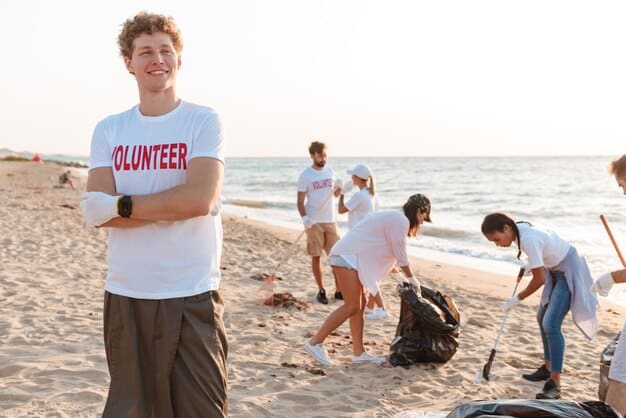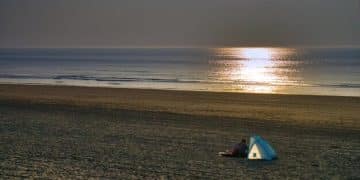Minimize Your Environmental Impact on US Beaches in 2025

Minimizing your environmental impact on US beaches in 2025 involves adopting responsible travel practices, supporting sustainable tourism initiatives, and actively participating in conservation efforts to preserve coastal ecosystems.
As we look to 2025, the imperative to protect our natural wonders, especially our beloved coastlines, intensifies. The beauty and ecological richness of US beaches are undeniable, yet they face increasing pressures from human activity and climate change. It’s more crucial than ever for travelers and locals alike to understand and implement strategies to ensure these pristine environments remain vibrant for generations. This article delves into 3 Ways to Minimize Your Environmental Impact on US Beaches in 2025, offering practical and impactful approaches for conscious travelers.
Responsible Travel Practices for Coastal Conservation
Embracing responsible travel is the cornerstone of minimizing your environmental footprint on US beaches. This isn’t just about general courtesy; it’s about making conscious choices that directly mitigate harm to delicate ecosystems. From how you pack to how you dispose of waste, every action carries a ripple effect on the coastal environment.
Conscious Packing and Waste Reduction
Before you even set foot on the sand, your packing choices can significantly influence your beach impact. Reducing waste starts at home and extends throughout your trip. Avoiding single-use plastics is paramount, given their devastating effects on marine life and coastal habitats.
- 👜 Pack reusable bags and containers for snacks and souvenirs.
- 💧 Carry a refillable water bottle to avoid purchasing plastic bottles.
- 🧴 Opt for reef-safe sunscreens to protect coral reefs and marine life.
- ♻️ Bring a small trash bag for personal waste if bins aren’t readily available.
Once on the beach, the responsibility continues. Dispose of all waste, including organic matter, properly in designated bins. Even seemingly harmless items like fruit peels can attract unwanted wildlife and disrupt the natural ecosystem. Consider taking part in a quick “2-minute beach clean-up” before you leave, picking up any stray trash you find.
Mindful Interaction with Wildlife and Natural Habitats
US beaches are vibrant ecosystems, home to a diverse array of wildlife, from nesting birds and sea turtles to delicate dune vegetation. Our interactions with these elements must be guided by respect and a deep understanding of their vulnerability. Disturbing wildlife, even unintentionally, can have severe consequences for their survival and reproductive cycles.
- 🐢 Keep a respectful distance from all wildlife, especially nesting birds and sea turtles.
- ⛔ Avoid walking on dune vegetation as it stabilizes the sand and prevents erosion.
- 🐕 Keep pets leashed and away from sensitive areas, especially during nesting seasons.
- 💡 Minimize light pollution at night, particularly during sea turtle nesting season, to avoid disorienting hatchlings.
Educating yourself about the local flora and fauna is also a crucial step. Many coastal areas have specific guidelines for interacting with wildlife, often posted at beach access points. Adhering to these local regulations is key to ensuring your visit doesn’t inadvertently harm the very nature you came to enjoy. Being a silent observer, rather than an active participant, is often the best approach to wildlife encounters.
Ultimately, responsible travel practices are about cultivating an attitude of stewardship. It means recognizing that you are a guest in a fragile environment and that your actions contribute to its health or its decline. By prioritizing waste reduction and mindful interactions with nature, you contribute significantly to preserving the pristine beauty of US beaches for everyone.
Supporting Sustainable Tourism Initiatives
Beyond individual actions, supporting sustainable tourism initiatives is a powerful way to minimize your environmental impact on US beaches. This involves choosing businesses, accommodations, and activities that prioritize ecological preservation and local community well-being. Your consumer choices have a direct influence on the viability of sustainable practices within the tourism industry.
Choosing Eco-Friendly Accommodations and Tour Operators
When planning your beach getaway, research accommodations and tour operators that have a proven commitment to sustainability. Many hotels, resorts, and tour companies are actively implementing green practices, from energy and water conservation to waste reduction and support for local conservation projects. Look for certifications or clear statements of their environmental policies.
- 🏨 Select hotels with recognized eco-certifications (e.g., LEED, Green Seal).
- ♻️ Prioritize accommodations that emphasize waste reduction and recycling programs.
- ⚡ Inquire about their energy and water conservation efforts.
- 🛶 Choose tour operators that practice responsible wildlife viewing and minimize their footprint.
These businesses often go beyond simple compliance, actively contributing to the health of the surrounding environment. By patronizing them, you encourage more businesses to adopt similar practices, creating a positive feedback loop for environmental stewardship within the tourism sector. Your economic support sends a clear message that sustainability matters to travelers.
Engaging with Local Conservation and Education Programs
Sustainable tourism also means engaging with the communities and environments you visit. Many coastal areas have local non-profits, volunteer groups, and educational centers dedicated to preserving beaches and oceans. Participating in their programs, even for a few hours, can provide invaluable insights and a direct way to contribute.
Consider joining a guided nature walk to learn about local ecosystems, or attending a presentation on marine conservation. These activities not only enrich your travel experience but also deepen your understanding of the challenges facing coastal environments. Supporting these initiatives, whether through volunteer work, donations, or simply attending their events, helps sustain their vital work.

Furthermore, sustainable tourism fosters a stronger connection between visitors and the destination. When travelers become informed and involved, they are more likely to act as advocates for conservation, sharing their experiences and inspiring others to be more mindful. This collective engagement is crucial for long-term environmental protection. Supporting local businesses that champion sustainable practices also contributes directly to the local economy while reinforcing environmentally sound operations.
By actively seeking out and supporting sustainable tourism initiatives, you transform your vacation into an opportunity for positive environmental impact. Your choices help drive change within the industry, ensuring that the natural beauty of US beaches remains accessible and vibrant for future generations.
Active Participation in Conservation Efforts
Beyond individual prevention and economic support, active participation in conservation efforts stands as a critical pillar in minimizing your environmental impact on US beaches. This goes beyond passive observation, inviting direct engagement in preserving these precious ecosystems. Whether through local clean-ups or citizen science, your hands-on involvement can make a tangible difference.
Joining Beach Clean-ups and Volunteer Programs
One of the most direct and impactful ways to contribute is by participating in organized beach clean-ups. Numerous organizations across the US regularly host events where volunteers systematically remove trash and debris from coastlines. These efforts are vital for protecting marine life from entanglement and ingestion, and for maintaining the aesthetic beauty of the beaches.
- 🗑️ Search for local beach clean-up events through organizations like the Ocean Conservancy or local park services.
- 🤝 Encourage friends and family to join you, amplifying the impact of your efforts.
- 🧤 Come prepared with gloves and appropriate sturdy footwear.
- 📊 Learn about data collection during clean-ups, which helps track pollution sources.
Even if an official clean-up isn’t scheduled, you can initiate your own mini-clean-up during your visit. Dedicate 15-30 minutes to collecting any litter you find near your spot. This simple act, often referred to as “pack it in, pack it out,” or “take three for the sea,” sets a positive example for others and directly reduces the amount of waste in the environment. It fosters a personal connection to the conservation effort.
Volunteer programs extend beyond just clean-ups. Many coastal nature centers and wildlife refuges seek assistance with tasks like dune restoration, native plant propagation, or monitoring sensitive wildlife populations. These opportunities provide a deeper level of engagement and allow you to learn directly from experts in the field, contributing to science-based conservation.
Advocating for Policy Changes and Educational Outreach
While on-the-ground actions are crucial, long-term environmental protection often hinges on policy changes and public awareness. Your voice, combined with that of others, can be a powerful tool for advocating for stronger environmental regulations, better waste management systems, and increased funding for conservation initiatives. This aspect of participation involves leveraging your influence beyond immediate physical actions.
- ✉️ Contact your local and state representatives to express support for environmental legislation.
- 🗣️ Share information about beach conservation challenges and solutions on social media.
- 📚 Support educational campaigns that raise awareness about marine pollution and habitat destruction.
- 🌐 Participate in citizen science projects that contribute data to conservation research.

Citizen science projects, for example, allow ordinary individuals to contribute valuable data to scientific research. This might involve reporting sightings of specific marine species, monitoring water quality, or tracking changes in coastal erosion. By participating, you become part of a larger network of data collectors, providing scientists with the information needed to make informed conservation decisions. It empowers individuals to become active monitors of their environment.
Education is another vital component. By sharing what you’ve learned about beach conservation with friends, family, and your broader community, you amplify the message and inspire others to adopt more sustainable behaviors. This collective shift in mindset and action is what ultimately drives significant environmental change. Active participation ensures that the conversation continues and that pressure for positive change is maintained.
In essence, active participation transforms you from a visitor to a steward. It’s about taking ownership of the health of our beaches and recognizing that everyone has a role to play in their preservation. By joining clean-ups, volunteering, and advocating for change, you contribute to a legacy of healthy, vibrant US beaches for generations to come, embodying the true spirit of environmental responsibility.
| Key Action | Brief Description |
|---|---|
| 🎒 Responsible Packing | Reduce waste by bringing reusable items and reef-safe products. |
| 🌱 Mindful Interaction | Maintain distance from wildlife and avoid disturbing natural habitats. |
| 🤝 Support Sustainable | Choose eco-friendly businesses and engage with local conservation efforts. |
| 🧹 Active Participation | Join clean-ups, volunteer, and advocate for policy change. |
Frequently Asked Questions
▼
Reef-safe sunscreen is formulated without oxybenzone and octinoxate, chemicals known to be harmful to coral reefs and marine life. These chemicals can cause coral bleaching and damage marine ecosystems, making the switch to mineral-based sunscreens crucial for protecting sensitive coastal environments.
▼
You can typically find local beach clean-up events through websites of environmental organizations like the Ocean Conservancy, Surfrider Foundation, or local governmental park services. Many coastal communities also have dedicated Facebook groups or community boards announcing upcoming volunteer opportunities. Checking with local visitor centers upon arrival can also provide current information.
▼
Sand dunes are vital for coastal protection and ecosystem stability. Their vegetation, like sea oats, helps anchor the sand, preventing erosion from wind and waves. Walking on dunes destroys this vegetation, making the dunes more susceptible to collapse and reducing their ability to protect inland areas from storm surges and rising sea levels.
▼
Plastic pollution, especially single-use plastics like bottles, bags, and straws, poses the greatest threat due to its persistence and tendency to break down into harmful microplastics. Fishing gear, cigarette butts, and Styrofoam are also highly problematic. Even small items can be ingested by marine animals or entangle them, causing severe injury or death.
▼
Yes, supporting local businesses, particularly those committed to sustainable practices, strengthens the local economy and encourages environmentally responsible operations. This reduces the carbon footprint associated with long supply chains and often means businesses are more invested in the health of their immediate environment, directly benefiting the coastal community and its resources.
Conclusion
Minimizing our environmental impact on US beaches by 2025 is not merely a suggestion, but a critical responsibility we all share. By embracing responsible travel practices, consciously supporting sustainable tourism initiatives, and actively participating in conservation efforts, we contribute significantly to the health and longevity of these invaluable coastal ecosystems. Every mindful choice, from packing a reusable water bottle to joining a beach clean-up, weaves into a larger tapestry of environmental stewardship, ensuring that the pristine beauty and ecological richness of US beaches endure for generations to come. Your commitment today shapes the coastline of tomorrow.





